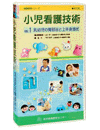| ■ Child Nursing Skill ( 3 volumes ) Japanese Version | |||||||||||||||

| Nursing assistance different from the one for adults is needed for child care. This is because they have difficulty in expressing what they feel painful or their symptoms in spoken words, their symptoms can change all of a sudden, or they can not understand the needs of the cures and treatments they are going to have. On the other hand, nurses are required to have nursing skills that are needed to ease their patient’s pain or stress and to bring out their patient’s ability to get over and recover from the diseases. Furthermore, nurses must have an ability to take measures or assessments appropriate to their patient’s developmental stage. This set of series emphasize backside bathing and upper-body bed-bathing, implementation of playing into cures and treatments (preparation), and emergency nursing among child nursing skills. Simply explains the purposes and methods of these skills, and the key points with real action movie, CG, and data. Thus, this set is so available and helpful. |
|
|||||||||||||
Copyright, Institute of A-V Medical Education INC. All Rights Reserved. |

|


